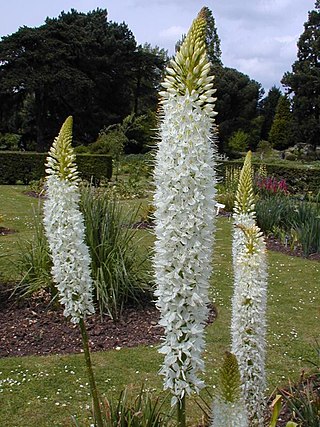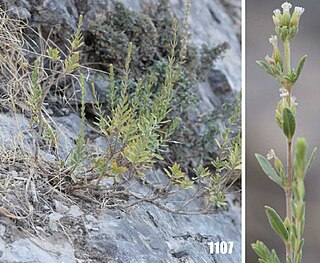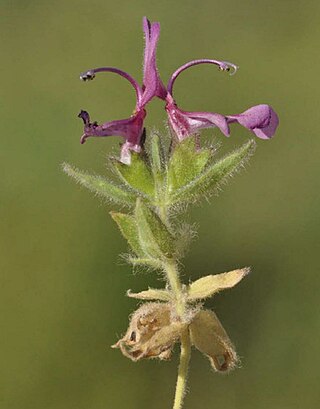
Gagea is a large genus of spring flowers in the lily family. It is found primarily in Eurasia with a few species extending into North Africa and one species in North America.

Ixiolirion is a genus of flowering plants native to central and southwest Asia, first described as a genus in 1821. Recent classifications place the group in the monogeneric family Ixioliriaceae in the order Asparagales of the monocots. In earlier systems of classification, it was usually placed in the family Amaryllidaceae.

Leonurus (motherwort) is a genus of flowering plants in the family Lamiaceae. It is native to Europe and Asia, naturalized in New Zealand, Hawaii, New Caledonia, and much of North and South America.

Eremurus is a genus of deciduous perennial flowers in the family Asphodelaceae. They are also known as the foxtail lilies or desert candles. They are native to eastern Europe in, and temperate Asia from Turkey to China, with many species in Central Asia.

Eminium is a genus of flowering plants in the family Araceae. The genus ranges from Turkey and Egypt east to Central Asia. Usually they can be found growing in barren areas in sand or stony soil. The foliage of Eminium resembles Helicodiceros and its inflorescence and fruit resembles those of Biarum.
- Eminium albertii(Regel) Engl. - Turkmenistan, Uzbekistan, Afghanistan
- Eminium heterophyllum(Blume) Schott - Iran, Iraq, Turkey
- Eminium intortum(Banks & Sol.) Kuntze - Turkey, Syria
- Eminium jaegeriBogner & P.C.Boyce - Iran
- Eminium koenenianumLobin & P.C.Boyce - Turkey
- Eminium lehmannii(Bunge) Kuntze - Kazakhstan, Kyrgyzstan, Turkmenistan, Uzbekistan, Afghanistan, Tajikistan
- Eminium rauwolffii(Blume) Schott - Turkey, Syria
- Eminium regeliiVved. - Kazakhstan, Kyrgyzstan, Tajikistan, Uzbekistan
- Eminium spiculatum(Blume) Schott - Egypt, Israel, Palestine, Jordan, Lebanon, Syria, Iraq, Iran

Amberboa is a genus of flowering plants in the family Asteraceae, described as a genus in 1832.
Microcephala is a genus of Asian flowering plants in the chamomile tribe within the daisy family.

Drepanocaryum is a genus of flowering plant in the family Lamiaceae, first described in 1954. It contains only one known species, Drepanocaryum sewerzowii, native to west, central and south-central Asia.

Gontscharovia is a genus of flowering plant in the family Lamiaceae, first described in 1953. It contains only one known species, Gontscharovia popovii, native to the mountains of south-central Asia.

Hypogomphia is a genus of flowering plants in the mint family, Lamiaceae, first described in 1873. It is native to Iran, Afghanistan, and Central Asia.
- Hypogomphia bucharicaVved. - Tajikistan
- Hypogomphia purpurea(Regel) Vved. ex Kochk. - Tajikistan
- Hypogomphia turkestanaBunge - Tajikistan, Kyrgyzstan, Uzbekistan, Afghanistan, Iran

Garhadiolus is a genus of Asian plants in the tribe Cichorieae within the family Asteraceae.

Gymnospermium albertii is a species in the genus Gymnospermium in the family Berberidaceae.

The taxonomy of Tulipa places the genus in the family Liliaceae, and subdivides it as four subgenera, and comprises about 75 species.
Rindera is a genus of flowering plants belonging to the family Boraginaceae.

Noaea is a genus of flowering plants belonging to the family Amaranthaceae. It is in the Salsoloideae subfamily.

Petrosimonia is a genus of flowering plants belonging to the family Amaranthaceae. It is also in the Salsoloideae tribe.
Sibbaldianthe is a genus of flowering plants belonging to the family Rosaceae. It is also in the Rosoideae subfamily.

Rochelia is a genus of flowering plants belonging to the family Boraginaceae. It is also in subtribe Eritrichiinae.
Metapion is a genus of beetles belonging to the family Brentidae. The species of this genus are distributed only in the Palearctic zone and likely originate from deserts of Central Asia. They are commonly found in Southern Europe, northern parts of the Middle East, Caucasus and in Central Asia. Some species also appear in northern zones of Africa. Ruta may be considered as a host plant for this weevil.
Turania is a genus of flowering plants in the amaranth family, Amaranthaceae. It includes four species native to Central Asia, ranging from Iran and Afghanistan to Xinjiang and Kazakhstan.


















